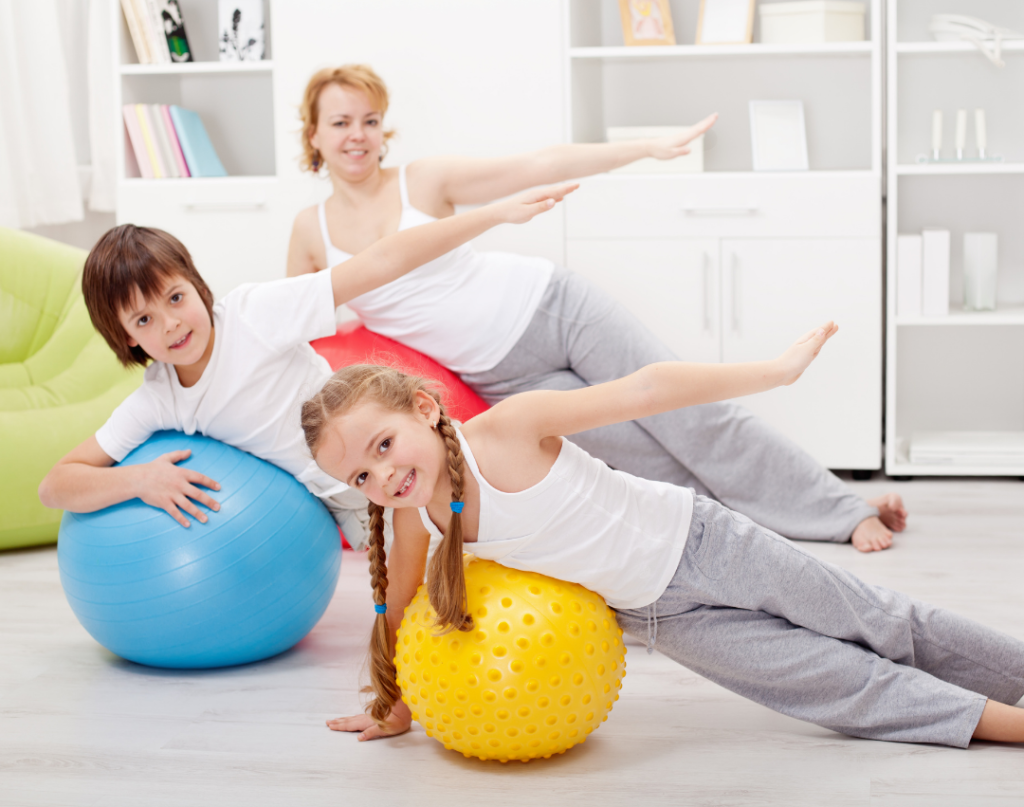Using a yoga ball (or exercise ball) is a great option for increasing your child’s strength and helping them meet their gross motor skills milestones and goals. Yoga ball exercises are versatile and can be tailored to the specific needs of each child. They can be used with infants, toddlers, and older children in a variety of ways to encourage muscle strengthening, stretching, jumping, sensory processing/regulation. Yoga balls come in a range of colors & sizes, and they are relatively inexpensive to purchase, which makes them a fun, easy, and affordable option in the home. Below is a list of examples of how you can use yoga balls to improve your child’s gross motor skills!
Core Strength for Baby
If your baby is still learning how to sit up independently and you’re looking for ways to strengthen their core muscles, place them in a supported sitting position on the yoga ball. While supporting their trunk or hips, gently rock the ball side to side and forward/backward. If your baby tolerates it, you can gently bounce them up and down! All of these will help to “turn on” their core and improve the strength of muscles that help babies sit up independently.
The parent’s hand placement can alter the level of support and increase/decrease the challenge. Supporting higher up under the baby’s arms or at their trunk will offer more support and make this easier. Supporting lower down at their pelvis or hips will make this more challenging and increase the work the baby’s core needs to do in order to stay upright on the ball.
Baby “Crunches”
If your baby tolerates the ball well, you can work on baby “crunches” on the ball. Support the baby’s trunk or pelvis and weight-shift them on the yoga ball to help them transition from lying on their back to sitting upright on top of the ball. This is typically done by shifting the ball backward and then forward as the baby starts to sit up. Meet your baby where they’re at and offer as much help as they need. Even if you feel like you are “doing the work”, your baby will often improve with practice!
Assisted Jumping on Ball
Wedge the yoga ball into a corner or against furniture so that it does not roll or wobble. Parents can stand up with their knees against the ball, securing it in place. With the ball secured, hold your toddler’s arms and assist them to jump up and down on the ball, using it as a mini-trampoline!
The parent’s hand placement should change depending on the child’s skill level for jumping. A child who needs more help will usually require support under their arms and a child who is more advanced may only require their hands to be held. Add in songs to make this more fun! Make sure to encourage your child to bend and extend their knees while jumping to teach them the right motor pattern for this skill.
Tummy Time
For infants who might not be the biggest fans of tummy time, an exercise ball can work very nicely to take some of the fear out of being placed on their tummy on the floor. By placing your baby on their tummy on the ball, and supporting them in this position, you can kneel down to eye level. This makes tummy time much more enjoyable for most babies, as caregivers can remain on their level, offer gentle rocking or bouncing of the ball, and change the degree of incline for the baby.
Tilting the baby downward slightly on the ball makes tummy time more challenging because the baby needs to push up against gravity. Tilting them slightly upward on an incline makes tummy time less challenging because gravity works in the baby’s favor by decreasing the work they must do to lift their head or reach in this position.
Body Awareness and Regulation
See the tip above regarding jumping on a yoga ball with assistance. This is a great way to provide lots of pressure to the joints, which we call “proprioception”. This helps the child to know where their body is in space, and it’s especially helpful for those little ones who like to “crash” into things, for those who might be “clumsy”, and also to help calm and regulate a child.
For tactile input, you can have the child lie on the floor on their back or tummy and gently roll or “squish” the yoga ball up and down their body, including both the trunk and extremities (arms and legs). Some children really enjoy this type of input, while others may not. Gauge the level of pressure you should use based on your child’s response to help determine if they are benefiting from this type of input.
Written by Jessica Tarence PT, DPT

